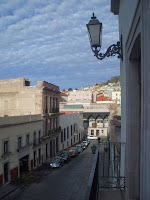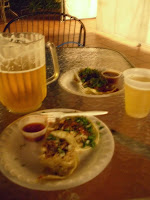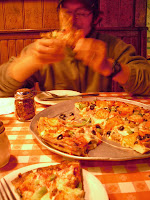It's a good morning when you drive to work, but instead of leaving your car and going to the office, you head to the road in front of your building to catch a cab. It's an especially good morning when you are taking that cab to the airport for a four-day vacation. It's an impeccably good morning when you see a double rainbow a minute before a taxi pulls up to you.
That rainbow was the first indication that our pre-holidays holiday in Zacatecas, capital city of a state northwest of Mexico City, would fall under fortunate skies. Just days before, we had the bad luck of having to change our plans because of our own ignorance. After reading a travel advisory a little too late, we realized more than half our trip was off-limits; fortunately, we were able to change our plans with little cost. The second sign of our charmed visit was the charming Christmas lights and decorations throughout the colonial town. Across the streets were bells, snowflakes, and even words wishing us "Feliz Navidad" (top left), in Mercado González Ortega were a Christmas tree and Santa's chair (top right), and in at least two parks were piles of poinsettias (bottom).
But the most all-out decked-out park was the Plaza de Armas, the courtyard in front of the state capital buildings and the city's cathedral. In between the church and a Christmas village, complete with the tallest tree in town (left), was a packed ice-skating rink (right). We thought about taking a spin, but the line for skate rentals was around the rink.
Before the skates were put on, the city put on a Christmas show. A band played carols as Santa Claus and the three wise men waved to the crowd from the ice rink (top). A couple of blocks away, in another plaza, a less traditional and more artistic display was being presented by the city's cultural association (bottom left). A day later, in yet another plaza, area indigenous tribes were celebrating with diverse dances and costumes (bottom right).
Another day later, we saw a few of those haylike headresses in one of the city's famous museums, which displays an enormous collection of masks owned by Rafael Coronel, a native artist and the son-in-law of Diego Rivera. The museum is housed in a 16th-century convent (top left), whose roofless cathedral makes an evocative exhibition area for Rafael's paintings (top right). His artist brother, Pedro Coronel, also has a museum in town, housed in a 17th-century seminary (bottom left). Its halls are filled with works by artists that influenced Pedro, but still, his own sculptures are featured in the courtyard (bottom right).
We educated our bellies about Zacatecas as much as we enculturated our minds. Our cab driver had clued us into the state's type of birria made from borrego (young sheep), as opposed to the typical beef and goat in Tijuana (top left). We had a couple of adobada then birria tacos as we snacked our way through the Saturday market in the city's Parque Bicentenario (top right). For one breakfast, we visited the dining institution Acropolis (bottom left), where Tim tried the local specialty, asado de boda (bottom right).By far, our most worthy meal was at Los Dorados de Villa (The Golds of the Village). The walls full of knickknacks and pictures definitely made you feel like you were eating in someone's house (top left), as did the customized, handmade ceramic plates (top right). Most of the featured dishes were basically variations on the enchilada, but serving them doused with sauce in cazuelas took them to a new level of comfort food (bottom left). The coup de grace, however, was the bathroom, which functioned as an open-air birdcage (bottom right), the sanitation of which would certainly not fly in the States.
Of course, we had to sample the local specialties in a glass, too. Pigus Micheladas served up the beer-juice mixes in more combinations than I thought possible. Surprisingly, I even enjoyed one of the blends, enough that I was willing to drink a liter of it (left). Being close to the eponymous city, León beer was available on many more menus than in our neck of Mexico, even at a Spanish-themed bar where we grabbed some tapas (right).
Perhaps due to a lingering Spainsh spirit, TJ managed to convince me to go to another bullfight, saying that it would feature more skilled sportsmen than the one we saw in Tijuana. Indeed, amid the eight matches in tribute to Zacatecas bullfighter Armando Montes, who was electrocuted when he was trying to repair a microwave, the matadors exhibited more flourish. Many penitently faced off with the bull as it entered the ring (left), and one performed all three stages of the bullfight, even mounting a horse to act as picador. The bulls were more feisty as well. One leaped over the inner wall and smack into the stone bleachers, then ran halfway around the outskirts before it was re-routed back into the ring, and another nearly gored one of the banderilleros after snagging his waistband with his horn. Still, I preferred the solace of the former bullring, which has been converted into the Quinta Real hotel (right).
Right in front of the luxury hotel are the remnants of an 18th-century aqueduct, built to bring water to the hilly city from a nearby mine. Now, no water flows through the channel, but cars drive through its arches (left). And plenty of water flows through the streams of Parque Enrique Estrada across the street (right).
The agua was also abundant in the fountains of Parque Sierra de Alica, yet another beautiful public green space (left). We strolled past a small Christmas market in the main arboreal promenade, the Alameda (right), as we made our way to one of the city's main attractions: its former silver and copper mine.
Across from the Parque Sierra de Alica is the Museo Francisco Goitia, one of the art museums in the city that we didn't visit (top left). Behind the museum lies the Parroquia de Nuestra Señora de Fátima, known for its pink stonework (top right). The Catedral de Zacatecas, with its more typical grey stone, is known for its intricate carvings (bottom).
The experience at Mina El Eden begins with a short but dark ride on a train into the main tunnels of the mine (top). Just to be safe, you are provided with hairnets and helmets to protect you from falling dust and rock. When you first disembark from the train, you can gaze at geological wonders in a small museum (bottom left) before a guide leads you, physically and verbally, along the mine's historical and production paths. At one point, we passed the nightclub contained within the mine (bottom right); initially, we thought ourselves too old for its disco scene, which starts at 10 p.m Thursdays through Saturdays, and by the time we found out that the bar opens at 3 p.m., sadly it was already Sunday.
A one-way walk through the mine lets you exit right next to the teleférico, a cable car that takes you up to the Cerro de la Bufa (top left). The operators really pack in the people, so it was hard to get a clear view -- or good photo -- of the city below (top right), but the view from the top of the peak, named for its "funny" appearance, was completely open and unobstructed (bottom).
Besides the excellent vista, the mountain has among its offerings a small chapel, a weather observatory, a museum, a mausoleum of the "illustrious men of Zacatecas" (left), and three statues of noteworthy Mexicans: Felipe Ángeles, a revolutionary war hero; Pánfilo Natera, former governor of Zacatecas state; and Francisco "Pancho" Villa, perhaps the most famous revolutionary general (right).
Since we were already following the typical tourist route, we decided to go all-out with a tour of the city on a double-decker Maxibus (left). On the ride, we saw many of the same sights we had already toured -- the museums, the churches, the parks -- but nonetheless it was fun to see the city through its second story (right).
And Zacatecas definitely has a more interesting story than we had expected. We knew that the city had a wonderful colonial center, but we didn't understand how expansive it was or how enjoyable it would be to watch the bustle from a balcony, whether it be attached to a cafe, like miDali cafe (top left), or to our room at Hostal Villa Colonial (top right). We also didn't realize how extensive the city's attractions would be; I mean, what city do you know that has a zipline, Tirolesa 840 (bottom left), in one of its most visited parks? Zacatecas is truly a mix of old and new, as seen within the many Volkswagen Beetles on its streets (bottom right).
Something old, something new -- that's part of the tradition of wedding, too, right? A while back, TJ told me the he wanted to get me a wedding ring for Christmas, but that he wanted me to help pick it out, to make sure I would like it. Zacatecas, with its long tradition of silver mining and designing, seemed like the perfect place to find one. And indeed, we found the perfect ring (only perhaps a bit big for my winter-shriveled fingers), at Centro Platero, bringing the good fortune of our trip full circle.















































































